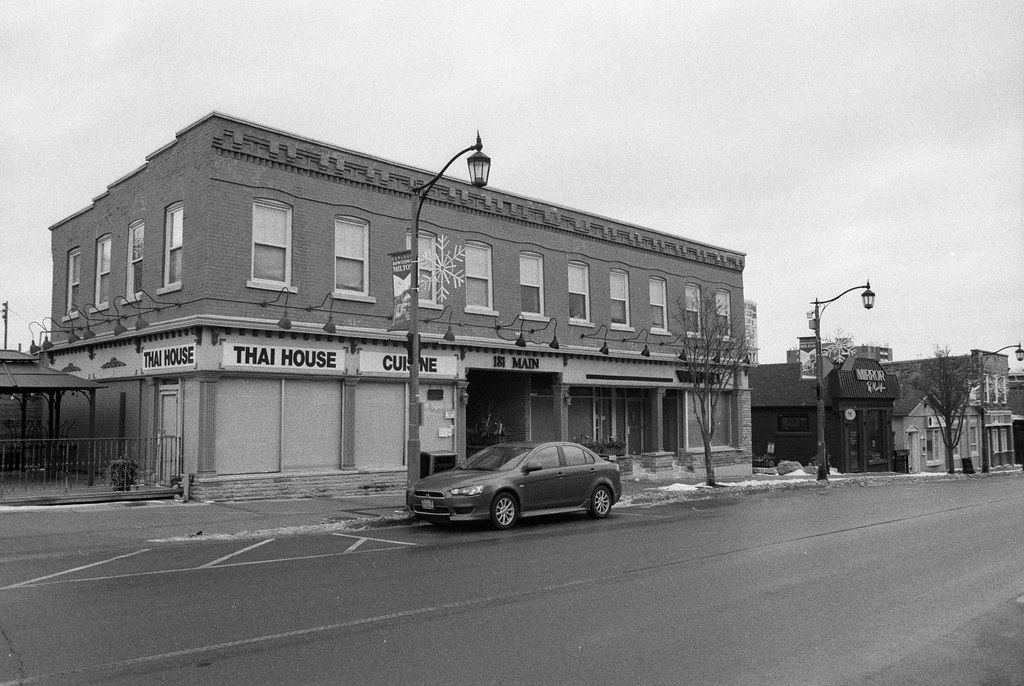I’m a big fan of prime lenses; they have always been a go-to for working with SLRs. And I have many options for my auto and manual focus Nikon kits. And while I have all my preferred focal lengths in my manual kit, I have been lacking a couple of options in my autofocus kit. Sure I have two fantastic zoom lenses with missing focal lengths, but they are both heavy and awkward to bring along when size matters. The problem is that even today, AF-D lenses can fetch a high price on the used market. So when someone offered up a couple of second-generation AF lenses for my Nikon AF kit, I was not about to say no. The 28mm f/2.8 is an excellent addition to my kit; while I often reach more for the 24mm lens, the 28mm offers a wide choice without being too wide, a nice balance between the 24mm and 35mm lenses in my kit. Plus, it matches the look of my other prime lenses despite not being a D-Type.
Lens Specifications
Make: Nikon
Model: AF Nikkor 28mm 1:2.8
Focal Length: 28mm
Focal Range: ∞ – 0.3m
Aperture: f/2.8 – f/22, 7 Blades
Structure: 5 Elements in 5 Groups

Nikon D750 – AF Nikkor 28mm 1:2.8
Build Quality
When Nikon first released their autofocuses lenses, the first generation lenses appeared closer to what you see with Minolta and Canon lenses of the era. This included a small and almost useless focusing ring, thinking photographers would completely do away with a manual focus with autofocus. Thankfully for the second-generation offerings, they updated the lens to have a larger, rubber-checked focusing ring, making it far more compatible. The outer body of the lens is plastic but remains robust in quality; the internal workings and the lens mount are metal and can take abuse better than plastic parts. Although I wouldn’t drop the lens on purpose, it could take a small fall without causing too much damage. The lens retains a physical aperture ring again to allow for better compatibility and a physical aperture linkage and AI(-S) style indent, but no claw. The front element does move when focusing, and a focusing scale is visible and protected by a clear plastic window. The lens takes a standard 52mm filter, so I can keep using all the filters I have for my Nikon kit. I also recommend adding an HN-2 hood; it helps reduce flare. The biggest issue with this lens is that it uses the older 5-element design taken from the Nikon Series E 28mm f/2.8 lens; this lens and the first-generation AF lens use this optical design. In comparison, I don’t see this as an issue; more on this in the next paragraph. If you want the ‘better’ 6-element design, you must step up to the third-generation or D-type lens.

Nikon D750 – AF Nikkor 28mm 1:2.8
Nikon D750 – AF Nikkor 28mm 1:2.8
Nikon D750 – AF Nikkor 28mm 1:2.8
Nikon D750 – AF Nikkor 28mm 1:2.8
Nikon D750 – AF Nikkor 28mm 1:2.8
Image Quality
Having shot the Series E 28mm f/2.8 in the past (I got the lens with my Nikon F3 and a professional photojournalist used it), I never had an issue with the quality of that lens. So when I saw that the AF Nikkor 28mm f/2.8 was the same optical construction (5-Element), I knew that this lens would do precisely what I wanted in a prime wide-angle lens. You do get a noticeable barrel distortion with this lens. This mostly appears when you’re focusing in close or have strong straight lines; thankfully, you can correct this in post-processing. And if you are using Adobe Photoshop or Lightroom, there is an automatic setting to fix this distortion. The second issue is that when shooting at f/2.8, you get noticeable fall-off and vignetting at your corners. Again, you can leave this in for a creative frame, or that automatic correction will handle the vignetting. The out-of-focus elements are nothing special but are rendered smoothly. There is a slight ghosting at the edges of these elements but nothing concerning. The one thing you don’t have to worry about is sharpness; this lens is sharp. And it’s sharp across all apertures. Even at f/2.8, the items in focus are sharp and only get better as you stop down. It would be best if you watched out for flare, so the HN-2 hood is an excellent addition to your kit. I’m lucky I already had a second HN-2 hood in my spare accessory bin.





Applications
The 28mm focal length is not one I use that often, but I have come to appreciate it more now that I’ve been using it. It’s the perfect in-between when you need something wider than 35mm but not as wide as 24mm. Ideal for landscape and streetscape work. Especially in areas where the streets are narrow. It allows you to capture the whole scene without losing your image’s context. This is the perfect lens as part of a travel kit, adding in the 35mm, 50mm and 105mm. But this lens also is excellent when doing professional event photography, great for capturing large groups when space is limited and for creative close-ups. It can also work for environmental portraits and street photography. The 0.3m closeup focus means that if it’s your thing, you can get in nice and close to your subject for some wild portraits. And having that f/2.8 aperture means you have excellent low-light performance, combine this with a wide-angle when shooting against a flat focal plane, and you can keep everything and everyone focused without needing to stop down. While you can use flash with this lens, it does not send distance information to the flash, meaning there might be a bit of inconsistency in your flash power settings when working in automatic modes. If this is important, spend the extra cash and use the third-generation D-Type lens. One of the best things is that this lens has a tonne of forwards and backwards compatibility; I can use this lens on any Nikon SLR that accepts AI-S lenses, which means my manual focus FE and FE2 can use this lens and so can my D750 without skipping a beat. The one thing to note is that any AF body that you mount this lens on must have an AF motor. If you are looking for a period-appropriate camera, look at the offerings from the late-1980s to the mid-1990s. The Nikon F4 is an excellent choice.





The Low Down
I like this lens; it does what you need without too much extra to make it rare or unique on the used market. And because it has a lower element count and is older, it doesn’t carry a hefty price tag. The first and second-generation copies are going for between 100 to 130$ on the used market, and often that’s with both front and rear caps and maybe even a box (if you’re into that). You are starting to look at 150$ and up for the third-generation D-Type lens. And while I’m not one for consistency in my lenses, I do like that at first glance; the 28mm f/2.8 looks like my other D-Type lenses. Do I need to update to the D-Type 28mm f/2.8? I probably will if this copy ever breaks, but despite its detractors, I don’t mind this lens. It has excellent image quality and does exactly what I need. I’m also not one to ‘pixel-peep’, so if I can squeeze off images that work and the quality is what I look for, then this lens will be perfect.
Further Reading
Don’t just take my view on the Nikkor 28/2.8; check out these other reviews.
No other Reviews found; most relate the later 28mm f/2.8D
